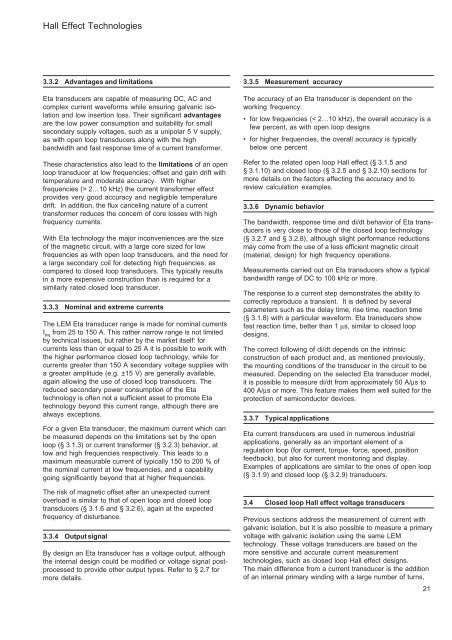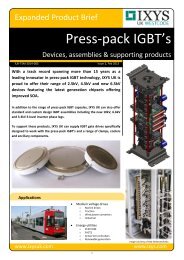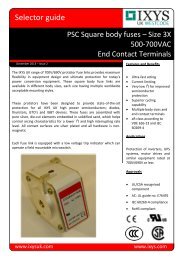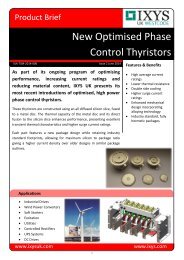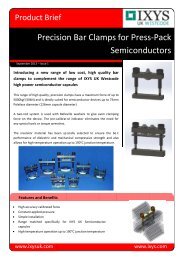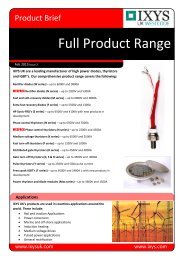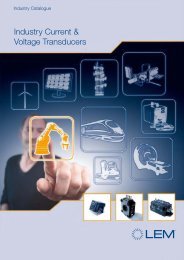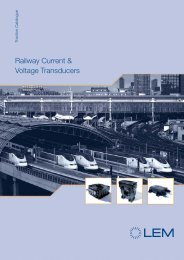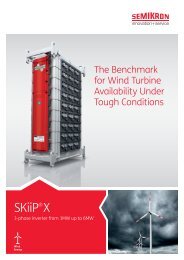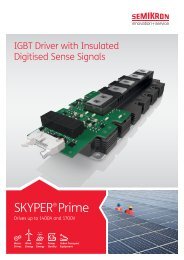isolated current voltage transducers
Create successful ePaper yourself
Turn your PDF publications into a flip-book with our unique Google optimized e-Paper software.
Hall Effect Technologies<br />
3.3.2 Advantages and limitations<br />
Eta <strong>transducers</strong> are capable of measuring DC, AC and<br />
complex <strong>current</strong> waveforms while ensuring galvanic isolation<br />
and low insertion loss. Their significant advantages<br />
are the low power consumption and suitability for small<br />
secondary supply <strong>voltage</strong>s, such as a unipolar 5 V supply,<br />
as with open loop <strong>transducers</strong> along with the high<br />
bandwidth and fast response time of a <strong>current</strong> transformer.<br />
These characteristics also lead to the limitations of an open<br />
loop transducer at low frequencies; offset and gain drift with<br />
temperature and moderate accuracy. With higher<br />
frequencies (> 2…10 kHz) the <strong>current</strong> transformer effect<br />
provides very good accuracy and negligible temperature<br />
drift. In addition, the flux canceling nature of a <strong>current</strong><br />
transformer reduces the concern of core losses with high<br />
frequency <strong>current</strong>s.<br />
With Eta technology the major inconveniences are the size<br />
of the magnetic circuit, with a large core sized for low<br />
frequencies as with open loop <strong>transducers</strong>, and the need for<br />
a large secondary coil for detecting high frequencies, as<br />
compared to closed loop <strong>transducers</strong>. This typically results<br />
in a more expensive construction than is required for a<br />
similarly rated closed loop transducer.<br />
3.3.3 Nominal and extreme <strong>current</strong>s<br />
The LEM Eta transducer range is made for nominal <strong>current</strong>s<br />
I PN<br />
from 25 to 150 A. This rather narrow range is not limited<br />
by technical issues, but rather by the market itself: for<br />
<strong>current</strong>s less than or equal to 25 A it is possible to work with<br />
the higher performance closed loop technology, while for<br />
<strong>current</strong>s greater than 150 A secondary <strong>voltage</strong> supplies with<br />
a greater amplitude (e.g. ±15 V) are generally available,<br />
again allowing the use of closed loop <strong>transducers</strong>. The<br />
reduced secondary power consumption of the Eta<br />
technology is often not a sufficient asset to promote Eta<br />
technology beyond this <strong>current</strong> range, although there are<br />
always exceptions.<br />
For a given Eta transducer, the maximum <strong>current</strong> which can<br />
be measured depends on the limitations set by the open<br />
loop (§ 3.1.3) or <strong>current</strong> transformer (§ 3.2.3) behavior, at<br />
low and high frequencies respectively. This leads to a<br />
maximum measurable <strong>current</strong> of typically 150 to 200 % of<br />
the nominal <strong>current</strong> at low frequencies, and a capability<br />
going significantly beyond that at higher frequencies.<br />
The risk of magnetic offset after an unexpected <strong>current</strong><br />
overload is similar to that of open loop and closed loop<br />
<strong>transducers</strong> (§ 3.1.6 and § 3.2.6), again at the expected<br />
frequency of disturbance.<br />
3.3.4 Output signal<br />
By design an Eta transducer has a <strong>voltage</strong> output, although<br />
the internal design could be modified or <strong>voltage</strong> signal postprocessed<br />
to provide other output types. Refer to § 2.7 for<br />
more details.<br />
3.3.5 Measurement accuracy<br />
The accuracy of an Eta transducer is dependent on the<br />
working frequency:<br />
• for low frequencies (< 2…10 kHz), the overall accuracy is a<br />
few percent, as with open loop designs<br />
• for higher frequencies, the overall accuracy is typically<br />
below one percent<br />
Refer to the related open loop Hall effect (§ 3.1.5 and<br />
§ 3.1.10) and closed loop (§ 3.2.5 and § 3.2.10) sections for<br />
more details on the factors affecting the accuracy and to<br />
review calculation examples.<br />
3.3.6 Dynamic behavior<br />
The bandwidth, response time and di/dt behavior of Eta <strong>transducers</strong><br />
is very close to those of the closed loop technology<br />
(§ 3.2.7 and § 3.2.8), although slight performance reductions<br />
may come from the use of a less efficient magnetic circuit<br />
(material, design) for high frequency operations.<br />
Measurements carried out on Eta <strong>transducers</strong> show a typical<br />
bandwidth range of DC to 100 kHz or more.<br />
The response to a <strong>current</strong> step demonstrates the ability to<br />
correctly reproduce a transient. It is defined by several<br />
parameters such as the delay time, rise time, reaction time<br />
(§ 3.1.8) with a particular waveform. Eta <strong>transducers</strong> show<br />
fast reaction time, better than 1 µs, similar to closed loop<br />
designs.<br />
The correct following of di/dt depends on the intrinsic<br />
construction of each product and, as mentioned previously,<br />
the mounting conditions of the transducer in the circuit to be<br />
measured. Depending on the selected Eta transducer model,<br />
it is possible to measure di/dt from approximately 50 A/µs to<br />
400 A/µs or more. This feature makes them well suited for the<br />
protection of semiconductor devices.<br />
3.3.7 Typical applications<br />
Eta <strong>current</strong> <strong>transducers</strong> are used in numerous industrial<br />
applications, generally as an important element of a<br />
regulation loop (for <strong>current</strong>, torque, force, speed, position<br />
feedback), but also for <strong>current</strong> monitoring and display.<br />
Examples of applications are similar to the ones of open loop<br />
(§ 3.1.9) and closed loop (§ 3.2.9) <strong>transducers</strong>.<br />
3.4 Closed loop Hall effect <strong>voltage</strong> <strong>transducers</strong><br />
Previous sections address the measurement of <strong>current</strong> with<br />
galvanic isolation, but it is also possible to measure a primary<br />
<strong>voltage</strong> with galvanic isolation using the same LEM<br />
technology. These <strong>voltage</strong> <strong>transducers</strong> are based on the<br />
more sensitive and accurate <strong>current</strong> measurement<br />
technologies, such as closed loop Hall effect designs.<br />
The main difference from a <strong>current</strong> transducer is the addition<br />
of an internal primary winding with a large number of turns,<br />
21


